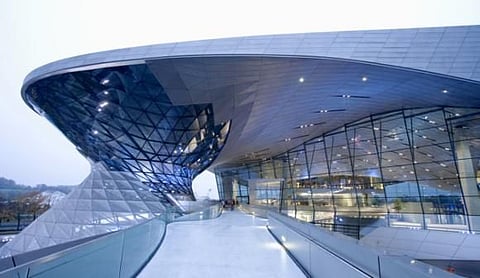Mixed up Munich
A mix of the old and new gives Munich character

Bavaria – like the UAE in a way – is also a mix of deeply traditional and hyper-modern. There’s a lot of churches and a lot of freeways and tall buildings. It’s this interesting mix of old and new that really defines Bavaria, and especially its capital. Munich is a sprawling city, but beyond it lie bucolic fields and kilometres of rolling greenery.
Marienplatz was also the spot where a less savoury but no less flamboyant display took place in the run-up to the Second World War – this was where Hitler tried to stage a coup in 1923. Bavaria, understandably, has tried to forget that the Nazi party’s origins lay here. But you can’t ignore the end results of terror, and nor should you. A quick ride out of Munich by the S-Bahn brings you to Dachau, one of the first concentration camps. Walking around in eerie silence is as sobering as it is terrifying – contemplating evil is essential to extinguishing it.
Modern Munich is thankfully a much more tolerant place, though a number of tragedies have stalked it too. You can pay homage to the Busby Babes – the great generation of Manchester United football players who perished in the Munich Air Crash of 1958 – at Manchesterplatz, where a memorial sits. And in the Olympic Park there’s a memorial to the athletes killed during the 1972 Olympic hostage crisis. The Park is one of Munich’s greatest spaces – it’s all public. A huge space you can just explore at will. The Olympiaturm, the huge tower at its centre, looms up. Go to the top and you can get a marvellous view over the city.
One of the buildings you can spy on from up there in the sky is the BMW Headquarters. BMW is a Munich company through and through (the BMW car badges wear Bavaria’s blue and white colours). And petrolheads will enjoy the BMW Welt and company museum next to the HQ. It’s all very 70s – the dystopian movie Rollerball was shot here – perhaps because, as well as looking cool and futuristic, there’s also something a bit sinister and domineering about some of these corporate buildings – like BMW Welt, which is cast as the HQ of the all-powerful Energy Corporation in the film.
Cars went on to define modern Germany, and nowhere has more autobahns filled with more BMWs than Munich. This is the German Alphaville, its streets filled with Teutonic cars that are always clean and never dented. And similar to the precision BMWs are designed with, Munich loves its good design too.
In the new breed of design hotels such as the Cortiina and the Louis, sober and tasteful modern decor creates a luxurious backdrop. It’s all completely different to the wood-panelled stereotypes you might imagine. Modern Munich is flush with cash – incomes here are high. Plush restaurants such as the Brenner cater to affluent young things who head out on Friday nights after a hard week at the office.
Therme Erding is remarkable for being a huge mistake – oil companies thought they’d found a new source of black gold outside the cutesy little town of Erding, but instead hit a mineral spring – and this hugely popular waterworld opened up. With its glass domes it looks like a space station implausibly perched among meadows filled with mooing cows.
And if it was a capital city then what of its country? The outskirts of Munich blend so gently into the Bavarian landscape – the green country warmly embraces the city. The gap between urban and rural gently merges. It’s very pleasant to stroll or cycle along paths and lanes at this crossover point, and even to travel on the S-Bahn trains that ply between city and country, offering views of rail yards one second, small towns squares the next, and then rolling green vistas.
The emerald fields and the low golden hills are joyous on summer days when the light is good. This liminal hinterland doesn’t have the romance of Provence or the bravado of the Alps, which lie just away to the south, but in its own way it is a pleasing and very comforting landscape of flowers and trees.
The Museum für Konkrete Kunst in a former army barracks in Ingoldstadt is one of Germany’s most remarkable museum and gallery spaces – dedicated to the much-maligned influence of concrete on artists. There’s video art, a sculpture garden and architectural exhibits that will blow your mind. At the moment this place is hardly visited, but that will all change when Vienna’s Querkraft Architekten builds a new extension to the museum, which is scheduled to open in 2017.
Back in Munich there’s more eye-opening architecture to keep your senses sharp. The Allianz Arena, home to footballing powerhouse Bayern Munich, is so futuristic it could be a spaceship – especially when it lights up at night in different colours. And yet Herzog and de Meuron’s design, on closer inspection, is organic. It’s a living thing. Nature and technology united again – Bavaria’s calling card.
The best bit of Munich’s airport is Lufthansa’s Terminal 2 – an extension to which is being built. The terminal is one of the sleekest and calmest there is. The beauty, cleanliness, light and swagger is nothing special for Asia, but among European airport terminals, this is the bee’s knees. Anyone lucky enough to be flying on good old Lufthansa – the terminal is the airline’s secondary hub after Frankfurt – will also be lucky enough to wait for their flight in the utmost comfort, enjoying free cups of coffee and newspapers to boot.
It’s not easy to mix natural and man-made, traditional and modern. But Bavaria – and especially Munich – pulls off this trick with style.
Sign up for the Daily Briefing
Get the latest news and updates straight to your inbox



